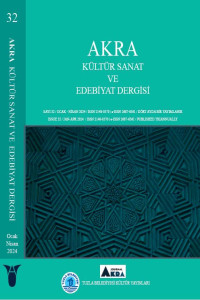Öz
Miftāḥu’l-Cinān adlı bu eser, 18. yy. Çağatay Türkçesiyle Yarkend’te Molla Kurban tarafından 6 Ağustos 1750 tarihinde yazılmıştır. 201 varaktan oluşmaktadır. Eser, 25 bab’a ayrılmıştır. Her bab da kendi içinde alt bölümlere bölünmüştür. Sayfalarda genel olarak 17 satır yer almıştır. Metnin aslı Arapçadır. Elimizdeki Türkçe nüsha, sonradan Farsçaya çevrilen metinden aktarılmıştır. Bu aktarılma, devrin valisi Muhammed Kürekani tarafından istenmiş ve halkın bu faydalı eseri anlaması için Çağatay Türkçesine çevrilmiştir. Bu bilgilere tezin ilk sayfalarında yer verilmektedir. Eser, İslami emir ve yasakları, önemli anlarda yapılması gereken ritüelleri, okunması gereken duaları, bazı dertlerden ve hastalıklardan kurtulmak için yapılması gerekenleri anlatan dinî bir metindir. 16. yüzyılda ilk kez Çağatay Türkçesine çevrilmiş olan eser, daha sonrasında çok kez tercüme edilmiş veya çoğaltılmıştır. Yedi elyazması ve beş taş basma metin, farklı ülke kütüphanlerinde bulunmuştur. Bu durum eserin çok yaygın ve önemli olduğunu göstermektedir. Çalışmada bunlardan en eski tarihlisi olan Paris nüshası esas alınmıştır. Makalede, eserin yazım ve dil özellikleri üzerinde durularak döneminin yazım anlayışı, dil bilgisi durumu ve müstensihin ortaya koyduğu tercihler belirtilmeye çalışılmıştır.
Anahtar Kelimeler
Miftahu’l-Cinan Doğu Türkçesi Çağatay Türkçesi Yeni Uygur Türkçesi Özbek Türkçesi
Destekleyen Kurum
Bu çalışma Erciyes Üniversitesi Bilimsel Araştırma Projeleri Koordinasyon Birimi tarafından SDK-2021-11039 nolu proje kapsamında desteklenmiştir.
Kaynakça
- Öztürk, Rıdvan. Yeni Uygur Türkçesi Grameri. Ankara: TDK, 2020.
- Argunşah, Mustafa. Çağatay Türkçesi. İstanbul: Kesit, 2013.
- Bodrogligeti, Andrâs J. E. A Grammar of Chagatay. Muenchen: Lincom Europa, 2001.
- Clauson, Sir G. An Etymological Dictionary of Pre~Thirteenth Century Turkish. Oxford: Oxford Press, 1972.
- Eckmann, J. Çağatayca El Kitabı (Günay Karaağaç). Ankara: TDK, 2017.
- Eckmann, Janos. Harezm, Kıpçak ve Çağatay Türkçesi Üzerine Araştırmalar (Osman Fikri Sertkaya). Ankara: TDK, 2017.
- Emet, Erkin. Doğu Türkistan Uygur Ağızları. Ankara: TDK, 2015.
- Gülen, Beste. «Türkçede -mak ve -maklIk Eylemlikleri Üzerine İşlevsel Bir İnceleme (Hacettepe Üniversitesi, Sosyal Bilimler Enstitüsü, Türk Dili ve Edebiyatı Anabilim Dalı, Türk Dili Bilim Dalı, Yüksek Lisans Tezi).» Ankara, 2020.
- Gabain, A. V. Eski Türkçenin Grameri (Mehmet Akalın). Ankara: TDK, 2000. https://sozluk.gov.tr/?/tonsuzla%C5%9Fma. tarih yok. 26 11 2023.
- Korkmaz, Zeynep. Gramer Terimleri Sözlüğü. Ankara: TDK, 1992.
Öz
This work titled Miftāḥu'l-Jinān was written in 18th century Chagatai Turkish by Molla Kurban in Yarkend on August 6, 1750. It consists of 201 varaks. The work is divided into 25 chapters. Each chapter is divided into subsections. There are generally 17 lines on the pages. The original text is in Arabic. The Turkish copy we have is a translation from the text that was later translated into Persian. This translation was requested by the governor of the time, Muhammad Kurekani, and translated into Chagatai Turkish so that the public could understand this useful work. This information is given in the first pages of the thesis. The work is a religious text that explains Islamic commands and prohibitions, rituals to be performed at important moments, prayers to be recited, and what to do to get rid of some troubles and diseases. In the 16th century, the work was translated into Chagatai Turkish for the first time and has been translated or reproduced many times since then. Seven manuscripts and five lithographs were found in libraries in different countries. This shows that the work is very widespread and important. This study is based on the oldest of these, the Paris copy. The article focuses on the spelling and linguistic features of the work and tries to indicate the spelling understanding of the period, the grammatical situation and the preferences revealed by the detector.
Anahtar Kelimeler
Miftahu Eastern Turkish Chagatai Turkish New Uyghur Turkish Uzbek Turkish
Kaynakça
- Öztürk, Rıdvan. Yeni Uygur Türkçesi Grameri. Ankara: TDK, 2020.
- Argunşah, Mustafa. Çağatay Türkçesi. İstanbul: Kesit, 2013.
- Bodrogligeti, Andrâs J. E. A Grammar of Chagatay. Muenchen: Lincom Europa, 2001.
- Clauson, Sir G. An Etymological Dictionary of Pre~Thirteenth Century Turkish. Oxford: Oxford Press, 1972.
- Eckmann, J. Çağatayca El Kitabı (Günay Karaağaç). Ankara: TDK, 2017.
- Eckmann, Janos. Harezm, Kıpçak ve Çağatay Türkçesi Üzerine Araştırmalar (Osman Fikri Sertkaya). Ankara: TDK, 2017.
- Emet, Erkin. Doğu Türkistan Uygur Ağızları. Ankara: TDK, 2015.
- Gülen, Beste. «Türkçede -mak ve -maklIk Eylemlikleri Üzerine İşlevsel Bir İnceleme (Hacettepe Üniversitesi, Sosyal Bilimler Enstitüsü, Türk Dili ve Edebiyatı Anabilim Dalı, Türk Dili Bilim Dalı, Yüksek Lisans Tezi).» Ankara, 2020.
- Gabain, A. V. Eski Türkçenin Grameri (Mehmet Akalın). Ankara: TDK, 2000. https://sozluk.gov.tr/?/tonsuzla%C5%9Fma. tarih yok. 26 11 2023.
- Korkmaz, Zeynep. Gramer Terimleri Sözlüğü. Ankara: TDK, 1992.
Ayrıntılar
| Birincil Dil | Türkçe |
|---|---|
| Konular | Tarihi Kuzey Doğu Türk Dili (Harezm, Kıpçak, Çağatay) |
| Bölüm | Araştırma Makaleleri |
| Yazarlar | |
| Erken Görünüm Tarihi | 11 Ocak 2024 |
| Yayımlanma Tarihi | 31 Ocak 2024 |
| Kabul Tarihi | 3 Ocak 2024 |
| Yayımlandığı Sayı | Yıl 2024 Cilt: 12 Sayı: 32 |


